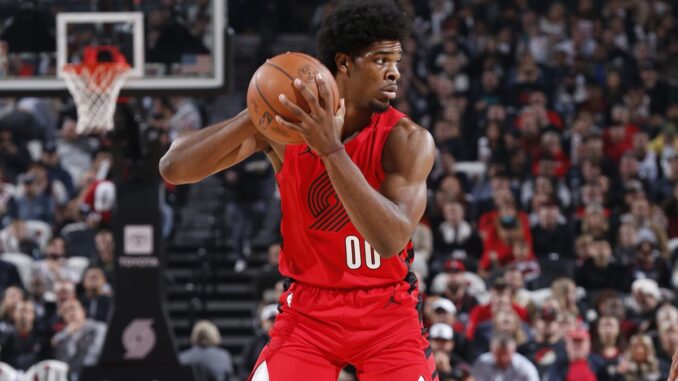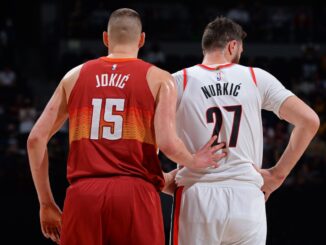
We’re about a week and a half into the season, and the Portland Trail Blazers have stumbled out of the gate. After the first game, Anfernee Simons injured his thumb, requiring surgery, keeping him out 4-6 weeks, thus putting more pressure on the young guard crew. Offensively, the team hasn’t clicked, being in the bottom third of the league in scoring and defensively giving up easy baskets. Hopes have been high for number three pick Scoot Henderson to help out on both ends of the court, but he’s off to a slow start. I’ve watched these opening games, focusing on Scoot, and here’s what I’ve noticed in this young season.
Other than Scoot’s athleticism, perhaps his next best skill was defense. In his draft evaluations, scouts touted his muscular frame, noting a potential ability to guard forwards on switches. Scouts also reported his quick lateral movement, allowing him to stay in front of fast guards. From what I’ve seen in this first set of games, Scoot’s getting lost on defense. While he may possess the physical attributes to play defense, the game is going fast for him.
Take the Clippers game, for example. Scoot was tasked with guarding Russell Westbrook for the majority of the game. Granted, Westbrook still has above-average athleticism and is one of the smartest point guards in the game, and he feasted on Scoot. Westbrook got by Scoot on numerous pick-and-rolls and dribble drives. Off-ball, Westbrook took advantage of Scoot easing up and dashed right down the middle of the lane for an easy two-handed dunk. I’m sure all eleven of Westbrook’s points came with Scoot guarding him.
Fast forward to the Sixers game versus Tyrese Maxey. Maxey is on his way to cementing himself in the top tier of point guards in the league (which is why the Sixers were able to dump Harden, but that’s for another column). Much like Westbrook, Maxey utilizes his athleticism to score. Maxey is probably the fastest open-court player in the league now that Westbrook is older. On numerous occasions, Scoot was slow to get back on defense, leading to open layups and dunks for the Sixers, especially Maxey. I’m noticing a trend while Scoot warms up to his jumper, where teams take advantage of Scott’s slow reaction back to the other end of the court. It happened a fair amount during the Clippers game, too, where Robert Covington, Russell Westbrook, and others had easy transition baskets with Scoot chasing them down. Going back to his matchup with Maxey, Scoot was constantly getting beat off the dribble. Once Maxey had Scoot on his hip, Scoot would stop, try and swipe at the ball, and either get called for a foul or give up an open attempt at the rim. This happened a lot versus Dennis Schroder and the Raptors. Schroder isn’t the most athletic guard, but he is savvy and shifty in his play. Scoot would routinely get beat thanks to quick jabs or fakes, and Scoot would plant and swipe at the ball. Through the first four games of the season, Scoot is averaging 4.5 fouls per game, even fouling out in the close Raptors game.
The knock on Scoot was his jump-shooting ability, and that’s been evident so far. Scoot is shooting 33% from the field and 5.6% from three. On his layups and drives, he’s finishing most of them, but the jump shooting is undoubtedly a problem. The good news for the Blazers is that there are enough perimeter shooters around to keep the spacing relatively fine. I look for Scoot to keep shooting, though, as he can’t stop improving this part of his game.
Even though his play has been raw in his first set of games in the league, it’s not all negative. During games, Scoot is the first person to help out a teammate who fell, as well as the first to give out high fives and praise. On the bench, he’s always the first to pop up after a dunk or a made shot to shout encouragements. These little things will help out morale-wise with the team—Scoot’s also great in transition and with a head of steam. There wasn’t one fastbreak when Scoot was the lead that I didn’t think he would convert the shot. Also, on pick and rolls or early in the shot clock, Scoot can finish at the rim using his acceleration to beat his defenders to the rim. He’s tossed up a couple of layups, and I’m still wondering how he even made them. He sees angles to make a shot around the rim that most players don’t.
I can fix Scoot’s problems on defense. Have you ever experienced being “in the zone”? I’m talking when you’re doing a repetitive task, like at your job or even washing dishes. You’re not even thinking about what you are doing because you’ve done it so many times. I took culinary classes in high school, so when cutting vegetables, I zone out because I did it so much back then, and my onions are always perfectly diced. Now, take learning a new version of your skill. You have to think so hard; you’re visualizing every step. Even though I diced plenty of onions, I still haven’t prepped enough pineapples to where I can perfectly core them or even make uniform slices. Let’s bring this back to Scoot. Henderson is a great NBA talent; there’s no denying that. He’s hit plenty of floaters and stolen many passes, but not in the NBA. He’s thinking way too much on the court, slowing his pace of play on the defensive end, and guards are aware of this. He needs to settle down and play, letting his instincts take over. I’m sure that’s easier said than done because playing in the NBA is such an exclusive club. Once Scoot gets comfortable with more reps and just plays basketball, he’ll settle in on the defensive side, opening up easy baskets offensively.



